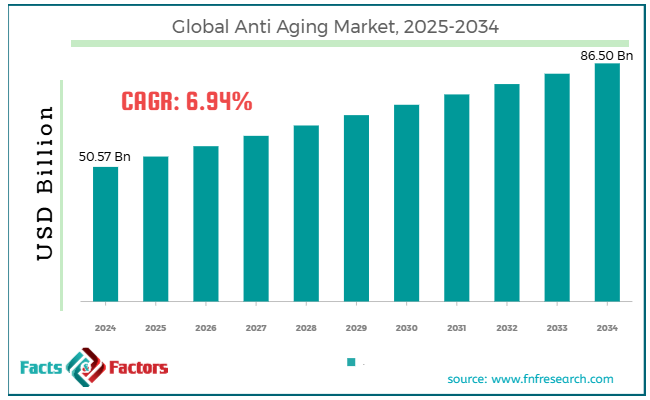Search Market Research Report
Anti Aging Market Size, Share Global Analysis Report, 2025 – 2034

Anti Aging Market Size, Share, Growth Analysis Report By Type (Products And Devices), By Application (Skin Resurfacing, Anti-Pigmentation, Anti-Wrinkle Treatments, And Others), By Distribution Channel (Specialty Beauty Stores And Hypermarkets/Supermarkets), And By Region - Global Industry Insights, Overview, Comprehensive Analysis, Trends, Statistical Research, Market Intelligence, Historical Data and Forecast 2025 – 2034
Industry Insights
[212+ Pages Report] According to Facts & Factors, the global anti aging market size was valued at USD 50.57 billion in 2024 and is predicted to surpass USD 86.50 billion by the end of 2034. The anti aging industry is expected to grow by a CAGR of 6.94% between 2025 and 2034.

 Market Overview
Market Overview
Anti-aging refers to the treatments, products, and techniques used to slow down, prevent, and reverse the effects of aging. The primary goal is to reduce wrinkles, fine lines, collagen loss, and skin pigmentation. Some of the major areas of the aging regimen include nutricosmetics, aesthetic treatments, skincare products, and lifestyle modifications. Aging is a natural process where human skin loses its moisture and elasticity. Various factors, including stress, UV radiation, and pollution, accelerate the aging process.
 Key Insights
Key Insights
- As per the analysis shared by our research analyst, the global anti aging market size is estimated to grow annually at a CAGR of around 6.94% over the forecast period (2025-2034).
- In terms of revenue, the global anti aging market size was valued at around USD 50.57 billion in 2024 and is projected to reach USD 86.50 billion by 2034.
- Growing aging population is driving the growth of the global anti aging market.
- Based on the type, the device segment is growing at a high rate and is projected to dominate the global market.
- Based on applications, the anti-pigmentation treatment segment is anticipated to grow with the highest CAGR in the global market.
- Based on the distribution channels, the hypermarket and supermarket segment is projected to swipe the largest market share.
- Based on region, North America is expected to dominate the global market during the forecast period.
 Growth Drivers
Growth Drivers
- Growing aging population is driving the growth of the global market.
The surge in the aging population is driving the growth of the market. Additionally, the increasing life expectancy is expected to create a massive demand for anti-aging products and treatments in the coming years. Additionally, there is a growing demand for anti-aging solutions that can restore skin elasticity, reverse the signs of aging, and provide a more youthful appearance. Consumers proactively use anti-aging products in their early life to prevent and delay the signs of aging.
However, innovation of active ingredients and formulations in science-backed skin care regimen is likely to be a transformative force in the industry. These formulations contain high-efficacy ingredients, including plant stem cells, ceramide, bakuchiol, and several others, which are expected to provide intense benefits to consumers. The increasing inclination of consumers towards non-invasive aesthetic procedures is also likely to revolutionize the market. Solutions such as laser resurfacing, chemical peels, dermal fillers, and Botox are expected to drive the market's growth in the coming years.
Additionally, the rising trend of adopting cosmetic dermatology is anticipated to reshape the future of the market. Social media and beauty influencer culture are also playing a significant role in driving the industry's growth. Consumers' purchase decisions are increasingly driven by peer recommendations, product review content, and other content on platforms such as YouTube and Instagram.
Therefore, such a landscape is expected to boost the growth of the global anti aging market during the forecast period. For instance, Softwave introduced the Synchronous Ultrasound Parallel Beam, an anti-aging technology, in 2022. This technology is approved by the FDA for firming and lifting the skin on the face and neck.
 Restraints
Restraints
- High cost of premium products is a restraining factor in the global market.
Advanced anti-aging products are quite expensive due to the use of ingredients such as collagen boosters, retinol serums, and others. On the other hand, non-invasive treatments are also costly. Therefore, affordability emerges as a significant constraint in the anti aging industry's growth. Sometimes, anti-aging ingredients like retinoids do not suit every individual and may cause photosensitivity, peeling, or redness in users. Consequently, it negatively impacts the industry's growth.
 Opportunities
Opportunities
- Rapid expansion of e-commerce is expected to foster growth opportunities in the global market.
The market is witnessing developments in e-commerce globally, which is anticipated to foster numerous growth opportunities in the global anti aging market. Moreover, the surge in online channel sales volume is also likely to facilitate faster market growth. Platforms like Sephora and Amazon are becoming increasingly popular for online sales.
Additionally, there is a high demand for ingestible anti-aging products, including skin whitening supplements, antioxidant capsules, glutathione, and many others. Moreover, there is a significant shift toward clean-label, natural products aimed at combating the effects of aging.
Another significant factor positively influencing the industry's growth is the rising disposable income of people in emerging markets. Rapid urbanization in developing regions is also boosting people's investments in personal care and beauty aesthetic products.
Therefore, such a landscape is expected to expand the industry's scope in the coming years. For instance, L'Oréal successfully took ModiFace, an artificial intelligence entity, in 2022. It is an advanced AI algorithm expert in offering skin aging consultation.
 Challenges
Challenges
- Safety concerns are a big challenge in the global market.
Strict regulations by agencies such as the EMA, FDA, and SFDA create complexity in the market. Authorities impose restrictions on the use of certain ingredients, and there is also a lengthy approval cycle, which further limits the anti aging industry's growth.
 Report Scope
Report Scope
Report Attribute |
Details |
Market Size in 2024 |
USD 50.57 Billion |
Projected Market Size in 2034 |
USD 86.50 Billion |
CAGR Growth Rate |
6.94% CAGR |
Base Year |
2024 |
Forecast Years |
2025-2034 |
Key Market Players |
PMD Beauty, Revlon Inc., Oriflame Holding AG, Avon Products Inc., Shiseido Company Limited, The Estée Lauder Companies Inc., The Procter & Gamble Company, Beiersdorf AG, L'Oréal S.A., Unilever PLC, and others. |
Key Segment |
By Type, By Application, By Distribution Channel, and Region |
Major Regions Covered |
North America, Europe, Asia Pacific, Latin America, and the Middle East &, Africa |
Purchase Options |
Request customized purchase options to meet your research needs. Explore purchase options |
 Segmentation Analysis
Segmentation Analysis
The global anti aging market can be segmented by type, application, distribution channel, and region.
On the basis of types, the market can be segmented into products and devices. The product segment can be further bifurcated into hair color products, anti-stretch mark products, anti-wrinkle products, and other categories. The device segment can be further bifurcated into microdermabrasion devices, anti-cellulite treatment devices, radiofrequency devices, and others.
The product segment is anticipated to register significant growth with the high CAGR during the forecast period. The growing aging population worldwide is creating a strong demand for anti-aging products. Brands are adopting these products for visible age control benefits.
On the other hand, the younger demographic is adopting anti-aging products as part of their preventive skin care regimen. The significant shift towards dermatology ingestible supplements, such as niacinamide and vitamin C, is expected to revolutionize the market. Brands are highly utilizing biotechnology-based natural actives to enhance their product portfolios.
Additionally, there is a surge in products with multifunctional offerings, such as one product that offers brightening, hydration, antipollution, and firming qualities. Nutraceutical cosmetics are becoming mainstream products due to increased consumer awareness and education. Therefore, these factors are likely to boost the growth of the segment.
On the basis of applications, the market can be segmented into skin resurfacing, anti-pigmentation, anti-wrinkle treatments, and others. The anti-pigmentation treatment segment is likely to dominate the global anti aging market during the forecast period. Topical depigmenting products are leading the growth of the segment. The innovation of new actives offering multi-pathway benefits, along with the inhibition of melanin production, such as antipollution, brightening, and hydration, all in one, is another crucial factor positively influencing the growth of the segment.
Additionally, nanoencapsulation helps anti-aging active ingredients, such as glutathione and vitamin C, penetrate the skin more effectively, which in turn boosts traction among consumers. Furthermore, the growing popularity of chemical peels, laser treatments, and microdermabrasion among customers is likely to drive the segment's growth. The increase in investment in anti-pigmentation prevention practices, particularly among younger demographics, is also significantly contributing to the segment's development.
On the basis of distribution channels, the market can be segmented into specialty beauty stores and hypermarkets/supermarkets. The hypermarket and supermarket segment is expected to account for the largest share of the anti aging industry. Retail outlets are the primary points of sale for skincare products. Impulse purchases are a key factor in the segment's growth.
However, self-level comparison and promotional displays are among the other crucial factors boosting the sales volume in the market. These stores offer a broad range of products to choose from, which further attracts end-users. The exclusive offerings by brands, like product combos or loyalty incentives, further foster growth in the segment.
Fast-growing retail chains, such as Big Bazaar, Dmart, and Walmart, are expected to further widen the scope of the segment in the coming years. These stores also offer seasonal discounts, value packs, and free product sampling, which further engage customers.
 Regional Analysis
Regional Analysis
- North America to dominate the global market.
North America is expected to account for the largest share of the global anti aging market during the forecast period. One of the significant factors contributing immensely to the growth of the regional market is the presence of strong market players. The rise of the Gen Z population is an emerging trend likely to reshape the future of the North American market. The United States is the leading country in the region due to the growth of clinical-grade, formulated products in the area. Moreover, the increasing use of energy-based aesthetic devices is also a transformative force positively influencing the development of the regional market.
Also, Canada is an emerging market with a significant market share. One of the major factors driving the high growth rate of the regional market is the increasing awareness among people about the importance of preventive skincare. A robust pharmacy retail network, particularly for derma cosmetics, is fueling the growth of their regional market.
The Asia-Pacific is the fastest-growing regional market, driven by numerous factors, including the high popularity of K-beauty products, rising disposable income, and others. China is a leading market due to its rapid urbanization and the growing middle-class population.
China is also known for its homegrown brands, which are expected to further positively influence the market's growth. Japan is expected to dominate the market in the APAC region in the coming years due to its aging population. Japan is leading the market in functional cosmetics and scientific skincare, which is also anticipated to boost the growth of the regional market.
South Korea is a pioneer market in anti-aging product innovation. Its current products are known for their significant benefits, such as youthful and glass-like skin, which is also expected to support the growth trajectory of the regional market. For instance, Rubedo Life Science partnered with Beiersdorf AG in 2024 to develop an innovative anti-aging solution.
 Competitive Analysis
Competitive Analysis
The key players in the global anti aging market include:
- PMD Beauty
- Revlon Inc.
- Oriflame Holding AG
- Avon Products Inc.
- Shiseido Company Limited
- The Estée Lauder Companies Inc.
- The Procter & Gamble Company
- Beiersdorf AG
- L'Oréal S.A.
- Unilever PLC
For instance, LR Health and Beauty introduced ZEITGARD PRO, a cosmetic device, in 2022. It is used for home use and interchangeable beauty tools. Each of the tools offered different functions, such as anti-aging.
The global anti aging market is segmented as follows:
 By Type Segment Analysis
By Type Segment Analysis
- Products
- Devices
 By Application Segment Analysis
By Application Segment Analysis
- Skin Resurfacing
- Anti-Pigmentation
- Anti-Wrinkle Treatments
- Others
 By Distribution Channel Segment Analysis
By Distribution Channel Segment Analysis
- Specialty Beauty Stores
- Hypermarkets/Supermarkets
 By Regional Segment Analysis
By Regional Segment Analysis
- North America
- The U.S.
- Canada
- Mexico
- Europe
- France
- The UK
- Spain
- Germany
- Italy
- Rest of Europe
- Asia Pacific
- China
- Japan
- India
- Australia
- Southeast Asia
- Rest of Asia Pacific
- The Middle East & Africa
- Saudi Arabia
- UAE
- Egypt
- Kuwait
- South Africa
- Rest of the Middle East & Africa
- Latin America
- Brazil
- Argentina
- Rest of Latin America
Industry Major Market Players
- PMD Beauty
- Revlon Inc.
- Oriflame Holding AG
- Avon Products Inc.
- Shiseido Company Limited
- The Estée Lauder Companies Inc.
- The Procter & Gamble Company
- Beiersdorf AG
- L'Oréal S.A.
- Unilever PLC
Frequently Asked Questions

Copyright © 2024 - 2025, All Rights Reserved, Facts and Factors


